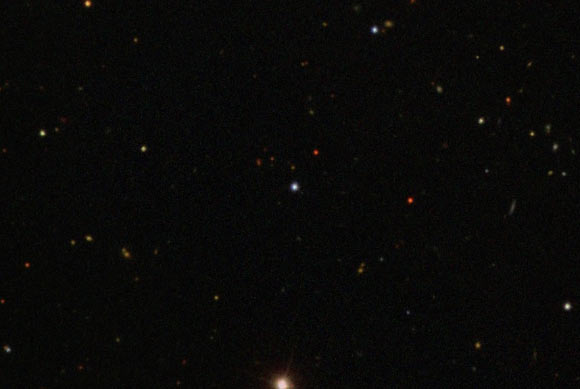Astronomers Find Huge Amount of Oxygen in Ancient Dwarf Star | Astronomy – Sci-News.com
Using high-resolution spectroscopic observations from the High-Resolution Echelle Spectrometer (HIRES) on the 10-m Keck I telescope at the W. M. Keck Observatory, an international team of astronomers and astrophysicists has detected large amount of oxygen in the atmosphere of SDSS J081554.26+472947.5 (J0815+4729 for short), an ancient dwarf star located 5,000 light-years away in the constellation of Lynx. The finding provides an important clue on how oxygen and other important elements were produced in the Universe’s first generations of stars.

This image shows the ancient dwarf star J0815+4729 (center). Image credit: Centre de Données astronomiques de Strasbourg / SIMBAD / SDSS.
Oxygen is the third most abundant element in the Universe after hydrogen and helium, and is essential for all forms of life on Earth, as the chemical basis of respiration and a building block of carbohydrates. It is also the main elemental component of the Earth’s crust.
However, this element didn’t exist in the early Universe; it is created through nuclear fusion reactions that occur deep inside the most massive stars, those with masses roughly 10 times the mass of the Sun or greater.
Tracing the early production of oxygen and other elements requires studying the oldest stars still in existence.
“Stars like J0815+4729 are referred to as halo stars,” said Dr. Adam Burgasser, an astrophysicist in the Center for Astrophysics and Space Science at the University of California San Diego.
“This is due to their roughly spherical distribution around the Milky Way, as opposed to the more familiar flat disk of younger stars that include the Sun.”
Halo stars like J0815+4729 are truly ancient stars, allowing astronomers a peek into element production early in the history of the Universe.
Dr. Burgasser and colleagues measured the abundances of 16 chemical species in the atmosphere of J0815+4729, including oxygen.
“The primitive composition of the star indicates that it was formed during the first hundreds of millions of years after the Big Bang, possibly from the material expelled from the first supernovae of the Milky Way,” said Dr. Jonay González Hernández, a postdoctoral researcher in the Instituto de Astrofísica de Canarias and the Universidad de La Laguna, Spain.
The HIRES data of J0815+4729 revealed a very unusual chemical composition.
While the star has relatively large amounts of carbon, nitrogen, and oxygen — approximately 10, 8, and 3% of the abundances measured in the Sun — other elements like calcium and iron have abundances around one millionth that of the Sun.
“Only a few such stars are known in the halo of our Galaxy, but none have such an enormous amount of carbon, nitrogen, and oxygen compared to their iron content,” said Dr. David Aguado, a postdoctoral researcher at the University of Cambridge.
“Thirty years ago we started to study the presence of oxygen in the oldest stars of the Galaxy; those results had already indicated that this element was produced enormously in the first generations of supernovae,” said Dr. Rafael Rebolo, from the Instituto de Astrofísica de Canarias, the Universidad de La Laguna and the Consejo Superior de Investigaciones Científicas.
“However, we could not imagine that we would find a case of enrichment as spectacular as that of this star.”
The discovery is reported in a paper in the Astrophysical Journal Letters.
_____
Jonay I. González Hernández et al. 2020. The Extreme CNO-enhanced Composition of the Primitive Iron-poor Dwarf Star J0815+4729. ApJL 889, L13; doi: 10.3847/2041-8213/ab62ae






